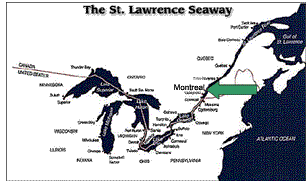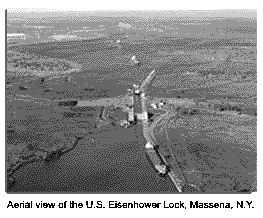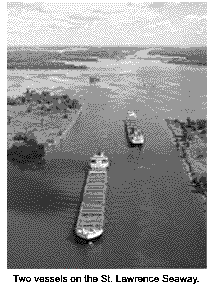The St. Lawrence Seaway is an engineering marvel that also represents close political cooperation between the United States and Canada. A complex series of locks, canals, and waterways, it provides a link between the Great Lakes and the Atlantic Ocean.
While the ultimate version of the seaway was constructed in the mid-20th century, its origins can be traced back to the 17th century, when the French attempted to build a canal to bypass the rapids at Lachine near Montreal, Quebec. While the effort failed for technical and economic reasons, the effort was based on the same objectives that would motivate future projects — producing power and improving navigation. A canal at Lachine was finally completed in 1825 and remained in operation until 1970, when it closed due to the success of the St. Lawrence Seaway.
 While many individual locks and canals permitted waterborne traffic to transit between the Great Lakes and the Atlantic, the St. Lawrence Seaway was envisioned as a means to ensure uniformity so that very large ships could make the journey without undue delays. The need for such a seaway was acknowledged by both countries in the St. Lawrence Deep Waterway Treaty, or what also is called the Hoover-Bennett Treaty, in 1932. No action, however, was taken until well past the end of World War II because of opposition from groups in the United States and the attack on Pearl Harbor. Because of fears of invasion from the Germans and Japanese, the St. Lawrence River was closed to traffic during the war.
While many individual locks and canals permitted waterborne traffic to transit between the Great Lakes and the Atlantic, the St. Lawrence Seaway was envisioned as a means to ensure uniformity so that very large ships could make the journey without undue delays. The need for such a seaway was acknowledged by both countries in the St. Lawrence Deep Waterway Treaty, or what also is called the Hoover-Bennett Treaty, in 1932. No action, however, was taken until well past the end of World War II because of opposition from groups in the United States and the attack on Pearl Harbor. Because of fears of invasion from the Germans and Japanese, the St. Lawrence River was closed to traffic during the war.
 After the war, more challenges forced the delay of construction until 1954. It was a formidable task that included moving more than two hundred million cubic yards of earth. It replaced a waterway with a depth of 14 feet with one that ran 27 feet deep and reduced the number of locks from 30 to 15. A lock is a section of waterway that the level can be adjusted either higher or lower, depending on the section after it. Construction required a considerable amount of flooding of populated areas, and around 6,500 people, mostly Canadians, were relocated to new towns.
In addition to improved navigation, the seaway enabled both Ontario Hydro and the New York State Power Authority to develop hydroelectric facilities.
After the war, more challenges forced the delay of construction until 1954. It was a formidable task that included moving more than two hundred million cubic yards of earth. It replaced a waterway with a depth of 14 feet with one that ran 27 feet deep and reduced the number of locks from 30 to 15. A lock is a section of waterway that the level can be adjusted either higher or lower, depending on the section after it. Construction required a considerable amount of flooding of populated areas, and around 6,500 people, mostly Canadians, were relocated to new towns.
In addition to improved navigation, the seaway enabled both Ontario Hydro and the New York State Power Authority to develop hydroelectric facilities.
 The seaway was officially opened in 1959. The cost of US$470 million was shared between the two national governments, with Canada paying $336 million and the United States $134 million. To recognize that disparity, revenues from operations are shared in that proportion.
The seaway's opening was officiated by Queen Elizabeth II and President Dwight D. Eisenhower. As of 2005, it handled around 200 million tons annually. Most of the tonnage is such bulk commodities as grain, iron ore, coal, and steel. Finished goods are now primarily shipped in containers, and shipments inland from Montreal are handled more economically by rail.
The seaway was officially opened in 1959. The cost of US$470 million was shared between the two national governments, with Canada paying $336 million and the United States $134 million. To recognize that disparity, revenues from operations are shared in that proportion.
The seaway's opening was officiated by Queen Elizabeth II and President Dwight D. Eisenhower. As of 2005, it handled around 200 million tons annually. Most of the tonnage is such bulk commodities as grain, iron ore, coal, and steel. Finished goods are now primarily shipped in containers, and shipments inland from Montreal are handled more economically by rail.